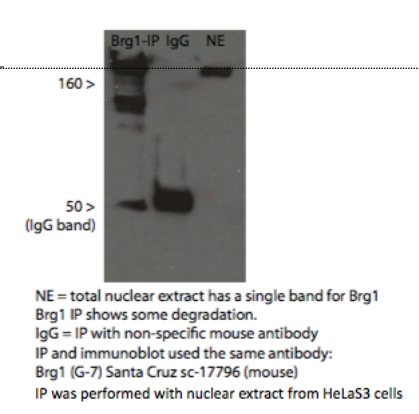ENCAB000AEO
Antibody against Homo sapiens SMARCA4
Homo sapiens
HeLa-S3, bipolar neuron
characterized to standards with exemption
- Status
- released
- Source (vendor)
- Santa Cruz Biotech
- Product ID
- sc-17796
- Lot ID
- H1104
- Characterized targets
- SMARCA4 (Homo sapiens)
- Host
- mouse
- Clonality
- monoclonal
- Purification
- other
- Antigen description
- Brg-1 (G-7) is raised against amino acids 209-296 mapping near the N-terminus of Brg-1 of human origin.
- External resources
Characterizations
SMARCA4 (Homo sapiens)
Method: immunoprecipitation followed by mass spectrometry
exempt from standards
- Caption
- Methodology: HeLaS3 whole cell lysates were immunoprecipitated using sc17796, and the IP fraction was loaded on a 10% polyacrylamide gel (NuPAGE Bis-Tris Gel) and separated with an invitrogen NuPAGE electrophoresis system. The gel was silver-stained, gel fragments corresponding to the bands indicated were excised and destained using the SilverSNAP Stain for Mass Spectrometry (Pierce). Then proteins were trysinized using the in-gel digestion method. The samples were subjected to nanoflow chromatography using the nanoAcquity UPLC system (Waters Inc.) prior to introduction into the mass spectrometer for further analysis. Mass spectrometry was performed on a hybrid ion trap LTQ Orbitrap mass spectrometer (Thermo Fisher Scientific) in positive electrospray ionization (ESI) mode. The spectra was acquired in a data dependent fashion consisting of full mass spectrum scan (300-2000 m/z) followed by MS/MS scan of the 3 most abundant parent ions. For the full scan in the orbitrap the automatic gain control (AGC) was set to 16106 and the resolving power for 400 m/z of 30,000. The MS/MS scans were done using the ion trap part of the mass spectrometer at a normalized collision energy of 24 V. Dynamic exclusion time was set to 100 s to avoid loss of MS/MS spectral information due to repeated sampling of the most abundant peaks. Sequence data from MS/MS spectra was processed using the SEQUEST database search algorithm (Thermo Fisher Scientific). The resulting protein identifications were brought into the Scaffold visualization software (Proteome Software) where the information was further refined resulting in improved protein id conformation. Scaffold search criteria were set at 98% probability and required at least 2 unique peptides per id. Mass spectrometry identifies Brg1/SMARCA4 as the major component of the material immunoprecipitated with antibody sc-17796 and excised from the bands indicated in the figure. A more detailed presentation of this data has been published (Euskirchen et.al., (2011) PLoS Genetics, 7(3):1-20), where an analysis of all associated proteins in presented. This work confirms previous observations that many components of the SWI/SNF complex are associated with Brg1/SMARCA4, including three additional members, BAF155/SMARCC1, BAF170/SMARCC2, and Ini1/SMARCB1, for which ENCODE ChIP-seq datasets are currently available.
- Submitter comment
- We'd like an exemption for this characterization.
- Reviewer comment
- This is being exempted for ENCODE3 standards because it passed ENCODE2 standards and has been in continual use.
- Submitted by
- Michael Snyder
- Lab
- Michael Snyder, Stanford
- Grant
- U54HG004558
- Download
- human_BRG1_validation_Snyder.pdf
SMARCA4 (Homo sapiens)
HeLa-S3
compliant
- Caption
- A band consistent with the expected size of Brg1/SMARCA4 (~185kD) is observed in immunoblots using sc-17796 against nuclear lysate from HeLaS3. This band is immunoprecipitated by antibody sc-10757 from HeLaS3 nuclear lysate, along with another major band at ~150kD. Mass spectrometry confirms that both bands contain Brg1 in high abundance (see validation #2).
- Submitted by
- Michael Snyder
- Lab
- Michael Snyder, Stanford
- Grant
- U54HG004558
- Download
- IP_Western_Brg1.png
SMARCA4 (Homo sapiens)
bipolar neuron
exempt from standards
- Caption
- The ENCODE Binding Working Group finds for some valuable biosamples that recreating a primary on well characterized antibodies is not cost effective. Therefore, they allow exemption from standards for these samples.
- Submitter comment
- The lab is asking for an exemption for IPSCs and biopolar spindle neurons (IPSC-derived) cells due to the lack of resources to make a primary characterization for them
- Reviewer comment
- Exempted by the Feb 29, 2016 antibody review panel, pending valid secondary characterization and characterization of this antibody in two different cell types given the target cell type is limiting.
- Submitted by
- Mark Mackiewicz
- Lab
- Richard Myers, HAIB
- Grant
- U54HG006998
- Download
- No_biosample.png

